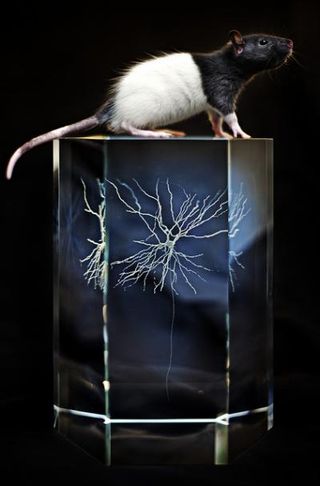
Scientists have watched a specific network of brain cells light up in rats to create a mental map of their location.
The new study, in which researchers looked at brain cells that literally turned on and off like light switches as rats navigated a maze, could shed light on how the brain creates a sense of place.
The study is published today (April 4) in the journal Science.
Finding our place
Scientists have known the hippocampus is involved in creating mental maps, but less certain is exactly how mental maps form or why we get lost. Past studies showed that specific place cells in the hippocampus fired when animals explored a new space, but knowing which brain cells sent information to the place cells proved trickier.
That's because tracing how any number of unknown brain cells, or neurons, are hooked up can be incredibly complicated — even in relatively simple animals such as rats.
"A rat's brain is the size of a grape. Inside there are about fifty million neurons that are connected together at a staggering 450 billion places," said study co-author Edvard Moser, director of the Kavli Institute, in a statement.
Sign up for the Live Science daily newsletter now
Get the world’s most fascinating discoveries delivered straight to your inbox.
Mental maps
To watch the entire process of learning a new place unfold, Moser and his colleagues created a virus that could insert tiny biological light switches into the neurons of rats. Next, they threaded optical fiber into the rats' brains to connect to the light-switch-enhanced brain cells, allowing the researchers to turn the lights on and activate the neurons at will. Finally, they inserted electrodes that could record electrical signals traveling between different brain cells.
The team flipped those biological light switches on and off about 10,000 times as rats navigated a maze seeking tasty treats, which enabled the scientists to identify individual neurons. Simultaneously, they measured the electrical signals traveling between these brain cells.
By combining the two pieces of information, the team was able to recreate the neural network that fires as the animals learned their location. It turned out that many different cell types were involved in creating a sense of place.
The findings raise questions about cells that have not previously been tied to orientation.
"One mystery is the role that the cells that are not part of the sense of direction play. They send signals to place cells, but what do they actually do?" Moser said in a statement.
Follow Tia Ghose on Twitter @tiaghose. Follow LiveScience @livescience, Facebook & Google+. Original article on LiveScience.com.

Tia is the managing editor and was previously a senior writer for Live Science. Her work has appeared in Scientific American, Wired.com and other outlets. She holds a master's degree in bioengineering from the University of Washington, a graduate certificate in science writing from UC Santa Cruz and a bachelor's degree in mechanical engineering from the University of Texas at Austin. Tia was part of a team at the Milwaukee Journal Sentinel that published the Empty Cradles series on preterm births, which won multiple awards, including the 2012 Casey Medal for Meritorious Journalism.
Most Popular


